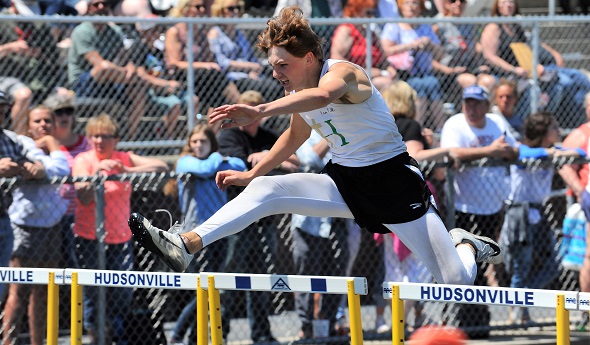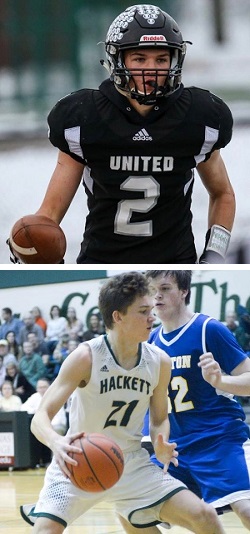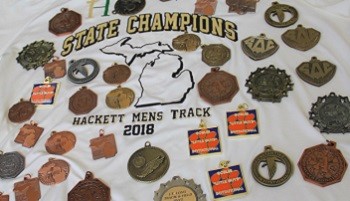
Baldwin Makes Wise Choice to Try Track
By
Pam Shebest
Special for MHSAA.com
March 26, 2019
KALAMAZOO — Three years ago, Heath Baldwin was sitting in the stands watching his sister, Hope, play volleyball when he started chatting with head coach Lauren Cholometes’ husband.
 The current Kalamazoo Hackett Catholic Prep senior had no clue that chitchat would turn into a life-changing event.
The current Kalamazoo Hackett Catholic Prep senior had no clue that chitchat would turn into a life-changing event.
It turns out that Simon Cholometes was also Hackett’s track & field coach and owns Areté, a training center in Three Rivers where Baldwin’s buddy Eric Wenzel works out.
Intrigued, Baldwin – then a sophomore playing football, basketball and baseball – visited the facility.
“He set up a hurdle and had me do it, and I was pretty good at it so I wanted to try it,” said Baldwin, who was already playing baseball in the spring but added track to become a dual-sport athlete that season.
“Coach C convinced me to do (track),” he said. “I was more of a baseball guy until then. I gave it a try my sophomore year, and it went pretty well.
“This past year, I didn’t really have too many expectations going in. Then it kind of got big and I started to really love it.”
That is an understatement.
 That first season, two years ago, Baldwin qualified for the MHSAA Lower Peninsula Division 4 Finals in four events, finishing fifth in the 110-meter hurdles, eighth in the high jump, 10th in the long jump and 14th in the 300 hurdles.
That first season, two years ago, Baldwin qualified for the MHSAA Lower Peninsula Division 4 Finals in four events, finishing fifth in the 110-meter hurdles, eighth in the high jump, 10th in the long jump and 14th in the 300 hurdles.
Last year, as a junior, Baldwin led the Irish from a 38th-place finish in 2017 to the D4 meet championship, winning the 100 hurdles (14.83 seconds) and the long jump (22 feet, 2½ inches) while placing fourth in the 300 hurdles and seventh in the high jump.
The senior, who also has earned honors in football, basketball and baseball, is one of six finalists for the Detroit Athletic Club’s “Michigan High School Athlete of the Year” award, which will be presented in May.
His track success also has led to a scholarship at University of Michigan next year.
This spring, Cholometes hopes Baldwin can help lead the Irish back to the top.
“Our expectations are pretty high,” the coach said. “We lost a few key contributors, but there’s no reason the team shouldn’t be better than last year’s team.”
Baldwin’s goal this year is to hit the 23-plus foot mark in the long jump, something the coach said is a possibility.
“He’s got that athleticism, and combine that with how coachable he is, and he’s got a solid work ethic, too,” Cholometes said. “It’s been a joy to work with him, and to see him be successful like that is pretty cool.”
This season, the 6-foot-4 lanky senior gave up baseball to concentrate solely on track.
Football a family legacy
Baldwin earned his love of football from his father, Roger, who passed away in 2016.
 ‘My dad was a big football fan, and all my brothers had played,” Heath said. “My dad coached me until eighth grade.”
‘My dad was a big football fan, and all my brothers had played,” Heath said. “My dad coached me until eighth grade.”
As a junior varsity player for United, a Hackett and Kalamazoo Christian cooperative team, “They needed a kicker, and I kinda just started that and got pretty good at it,” he said.
That kicking carried over to his varsity play, and this year he made 48 of 53 extra-point attempts and booted field goals of 33 and 36 yards, earning him all-state first-team honors.
Baldwin performed double duty, catching 50 passes for 910 yards and 18 touchdowns at wide receiver as well.
“It’s a little disappointing I didn’t get to 1,000 (yards), but I’m not too mad about it,” he said. “It was a fun season. We had a good time, but I wasn’t really focused on stats until after the season.”
United coach Jesse Brown, whose team finished 11-1, said he is not surprised at Baldwin’s success in any sport.
“His size and speed are the two things that stand out the most,” Brown said. “There isn’t anything that he can’t do, from track, football, basketball and baseball.
“Hands down, he is one of the best high school athletes I have ever seen. He was clutch in so many tight games of the past few years, making unbelievable catches, field goals and even this year at defensive end.”
All-around opportunities
Of all his sports, basketball is his least favorite to play, Baldwin said, but he likes the camaraderie. He and many teammates have played together since their YMCA days.
The center was hoping to reach 1,000 career points as a three-year varsity starter, but fell 82 points short.
“I just tried to out-hustle everybody because I’m not the best shooter,” said Baldwin, who earned all-Southwestern Athletic Conference honors all three seasons. “I get rebounds and put-back points, get the scrappy points and they all add up.”
This year, he averaged 20.2 points per game, 8.1 rebounds and 2.1 blocks. He racked up 38 points in a game against Coloma and hit double digits in 20 of the team’s 21 games.
Coach Mark Haase said Baldwin became one of the team’s best free throw shooters this season.
“He has great athleticism and is even a better teammate though,” Haase said. “He became a decent 3-point shooter this year as well.
 “He has great agility and coordination. It also helps that he has played three sports each year in high school. It helps to make a more well-rounded athlete.”
“He has great agility and coordination. It also helps that he has played three sports each year in high school. It helps to make a more well-rounded athlete.”
Baldwin said track has become his favorite sport for several reasons.
“I like the adrenaline it gives you, just lining up, competing head-on-head with other people,” he said. “If you lose, you can’t blame it on anybody else, just you.
“I do like the individual aspect of the sport … you hold yourself accountable.”
Several Division II and III colleges were interested in Baldwin in both football and basketball, but he decided to continue his love for track.
“The bigger schools were coming around, and I wanted a bigger school because I’ve been at private schools my whole life with not very many kids in my class,” he said. “I wanted the bigger atmosphere.
“I knew I wanted to do Michigan State or Michigan. It was a pretty tough decision.
“I’m just grateful to Coach C for convincing me to do track because I never would be in the position I am in today.”
 Pam Shebest served as a sportswriter at the Kalamazoo Gazette from 1985-2009 after 11 years part-time with the Gazette while teaching French and English at White Pigeon High School. She can be reached at [email protected] with story ideas for Calhoun, Kalamazoo and Van Buren counties.
Pam Shebest served as a sportswriter at the Kalamazoo Gazette from 1985-2009 after 11 years part-time with the Gazette while teaching French and English at White Pigeon High School. She can be reached at [email protected] with story ideas for Calhoun, Kalamazoo and Van Buren counties.
PHOTOS: (Top) Kalamazoo Hackett’s Heath Baldwin takes on a hurdle during last season’s 110-meter Division 4 championship race. (Middle top) Baldwin, left, and track coach Simon Cholometes. (Middle) Baldwin was a standout on both the football and basketball teams as well. (Below) A shirt from last season shows many of Baldwin’s track & field accomplishments. (Track photo by RunMichigan.com, football by Daniel J. Cooke Photography and basketball by Scott Dales. Shirt and heads shots by Pam Shebest.)

Hastings Relays Reigns as State's Oldest Continuous Track & Field Meet
By
Steve Vedder
Special for MHSAA.com
April 10, 2024
Bob Branch remembers dabbling in other sports, but his first love was always running.
 The Hastings High School graduate admits he could never hit a baseball, football didn't especially appeal to him and basketball was just another way to spend time with friends. But for Branch, now 93, there was always track. That's the sport where his fondest and sharpest memories remain. And if you're talking track, many of his favorite memories come from participation in the state's oldest continuous track meet, the Hastings Relays.
The Hastings High School graduate admits he could never hit a baseball, football didn't especially appeal to him and basketball was just another way to spend time with friends. But for Branch, now 93, there was always track. That's the sport where his fondest and sharpest memories remain. And if you're talking track, many of his favorite memories come from participation in the state's oldest continuous track meet, the Hastings Relays.
Always held in early April, the meet dates back to 1937 – a bygone time that saw the first hostilities of World War II, gas at 20 cents a gallon and a loaf of bread selling for a dime.
And at a dusty old track surrounding the county fairgrounds in Hastings, a small relay event that included a scattering of participants from a dozen high schools was taking its first tentative steps.
Branch recalls a time when kids would run home after track practice because there were no buses, inexperienced young coaches had little actual knowledge of running fundamentals, and athletes looked at the sport as an afterthought after spending most of their high school days playing football and basketball.
 For Branch, the relays were the ideal way to ease into the track season.
For Branch, the relays were the ideal way to ease into the track season.
"I just liked to run," said Branch. "I remember I anchored a relay with my brother, and it always seemed cold when we had that meet. I remember teams would come from all over and you saw a lot of good athletes. Everybody seemed to have someone who was really good. Track wasn't very popular at that time, but I have a lot of good memories from running."
The Hastings Relays, which has changed formats and even names during its nearly nine-decade history, would traditionally kick off the track season. The meet was originally held at a makeshift quarter-mile track which surrounded the town's fairgrounds and was part of the city's annual Hastings Carnival – the track would become the midway during fair time.
The meet eventually moved to Johnson Field when the football field was dedicated in 1949 and ballooned to as many as 50 teams at its peak in 1957. For more than seven decades it was known as the Hastings Relays and then the Hastings Co-Ed relays before becoming the current Hastings Invitational, with the latest edition scheduled for Friday.
Johnson Field had a cinder track before it became an all-weather surface in the 1980s. During a time long before computers would be used to organize meet heats in mere minutes, Hastings coaches of all sports – defined as "volunteers" by the athletic department – would meet on the Friday before competition to hash out events.
People associated with the meet still recall the camaraderie built on those long Friday nights, followed by working what would often become 10-hour meets. Steve Hoke has been involved since watching his father, Jack, who coached teams at 15 of the meets beginning in 1951 and also had run in the first Hastings Relays. Steve Hoke later competed in the Relays as well during the early 1970s before becoming an assistant track coach, later the Hastings athletic director and now a volunteer worker.
"It was always a huge deal," said Hoke, who said the meet began as a pure relay event before transitioning to its current team format in the 1990s. "I remember we'd line the track the night before, and all the coaches would come to the house to organize everything. There was a brotherhood.”
 If you quiz many of the fleet of volunteers who've worked the relays over the years, each has a different memory from the meet. While Hoke describes the brotherhood and Branch the outstanding competition, others remember weather and the time a thunderstorm wiped out the line markings on the cinder track, or waking up to find three inches of snow that caused a rare cancellation of the meet. Others recall the shock of moving from the cinder to all-weather track or using the meet as an early measuring stick of what it would take to qualify for the state meet. The real old-timers remember the meet disappearing for three years during World War II.
If you quiz many of the fleet of volunteers who've worked the relays over the years, each has a different memory from the meet. While Hoke describes the brotherhood and Branch the outstanding competition, others remember weather and the time a thunderstorm wiped out the line markings on the cinder track, or waking up to find three inches of snow that caused a rare cancellation of the meet. Others recall the shock of moving from the cinder to all-weather track or using the meet as an early measuring stick of what it would take to qualify for the state meet. The real old-timers remember the meet disappearing for three years during World War II.
Hastings native and Western Michigan grad Tom Duits was the state’s second collegian to break the four-minute mile when he ran a 3:59.2 at a meet in Philadelphia in 1978. Duits, who ran in three Hastings Relays, was in line to join the U.S. Olympic team in 1980 before the United States pulled out of the games due to tension with Russia.
Duits has his own memories of the meet and the competition he faced there.
"I remember sunshine and being excited to be competing again. There were all these athletes swarming around; it was an awesome display of talent," he said. "It was always one of the best meets we'd be in. You could pretty much see the level of runners who would be at state, which made it a big deal. It was always early, but you could tell where you stood. It was great exposure."
Hastings track star Wayne Oom competed in four Hastings Relays from 1984-87. One of his sharpest memories was the difference between running on a raw cinder track versus the far more comfortable all-weather surface.
"Those cinders would grind into your skin," said Oom, part of the Hastings school record in the two-mile relay. "But I think it helped us because when we'd go to other tracks, it seemed we would run faster. I remember how competitive it was, especially in the distances. There were some great runners."
While participants have their unique memories, so do coaches. Former Saxons coach Paul Fulmer remembers 2008 when his team finished first on the boys side of the meet while his wife, Grand Haven coach Katie Kowalczyk-Fulmer, saw her girls team win the championship.
 "I knew we were one of the favorites to win because we were usually near the top of our conference and Regional," he said. "But then Katie's team was pretty good, and it was cool for them to win too."
"I knew we were one of the favorites to win because we were usually near the top of our conference and Regional," he said. "But then Katie's team was pretty good, and it was cool for them to win too."
Fulmer, who coached Hastings from 1978-81 and then 1985-2010, said at least part of the meet's popularity was derived from a unique way of scoring. Instead of individuals earning points solo, participants worked in pairs. For instance, two athletes would combine their shot put or long jump scores. New events such as the 1,500 relay and sprint medley were added.
"We had a tradition of being the state's oldest meet, and that was a big deal," Fulmer said. "And we ran a good relay; that attracted teams too. We took a lot of pride in that.
"And we'd get quite a lot of people to come to the meet. We'd set up until like 9 or 10 p.m., and then we'd have a party with all the coaches on Friday night."
While the meet has stretched 87 years, Branch said early participants and current runners have one thing in common: a drive to win. Branch ran in an era when the popularity of high school track was in its infancy. Today some of the best all-around athletes at a school are involved in the track program. The relays span the nearly nine decades in between.
"The quality of teams has gotten better and better," said Branch, the 1947 Lower Peninsula Class B Finals champ in the 220. "And this has made for a better meet. We would get guys who played football or baseball kind of drift into track, and that made the sport better. I think people began to appreciate track because we'd get teams from all over.
"We went from not really knowing what we were doing to track being a good sport. Even then, I'm not sure we appreciated what we had. We really liked the Hastings Relays and always wanted to do well there. It became popular and quite an honor to do well. Those are the kind of things I remember."
PHOTOS (Top) Racers run at the Hastings Relays, with several more awaiting their turns to compete at the longtime meet. (2) The author wrote on the 50th anniversary of the Relays for the Hastings Banner nearly 40 years ago. (3) Past athlete, coach and athletic director Steve Hoke shows some of the Relays awards from the 1930s. (4) Tom Duits was one of the state’s biggest track stars of the 1970s and ran in three Hastings Relays. (Top photo by Dan Goggins, Hoke photo provided by Steve Hoke and Duits photos provided by Tom Duits.)

